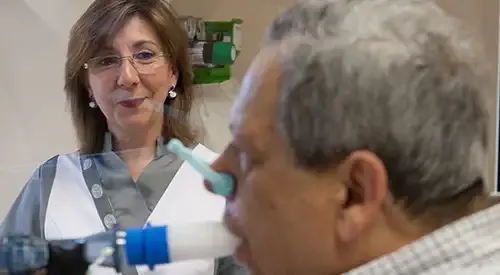Bronchial Asthma
"Making an accurate diagnosis sometimes requires testing with different treatments. But, once established, the treatment is usually very effective".
DR. ANA BELÉN ALCAIDE OCAÑA
SPECIALIST. PNEUMOLOGY DEPARTMENT

Asthma is a respiratory disease, characterized by chronic inflammation of the airways (bronchi), which causes recurrent episodes of shortness of breath (dyspnea), whistling in the chest with breathing (wheezing), coughing, and a feeling of tightness in the chest.
Bronchial asthma is characterized by occasional, reversible airway obstruction that, if not properly treated, can lead to permanent obstruction. It is frequently associated with other pathologies.
The Pneumology Department has been accredited as a Basic Asthma Unit by the Spanish Society of Pneumology and Thoracic Surgery (SEPAR).

What are the symptoms of bronchial asthma?
The three most common symptoms in patients with asthma are: wheezing (whistling in the chest with breathing), coughing, and dyspnea (choking sensation).
Asthma symptoms typically occur episodically and at any time of day, although it is common for them to appear predominantly at night and during the early morning hours.
The most common symptoms are:
- Breathing difficulty.
- Wheezing chest sounds.
- Chest tightness.
- Persistent dry cough.
Do you have any of these symptoms?
You may have asthma
What causes asthma?
The causes that provoke bronchial asthma are
- Extrinsic: Onset in childhood, with a positive family history for allergies and associated with a type 1 hypersensitivity and other allergic manifestations (IgE), induced by allergens such as pollen, wool, dust, etc., or air pollution, irritating substances, weather variations, aspergillosis and others.
- Intrinsic or idiopathic: Usually starts in over 35 years and no personal or family history. It begins by non-immunological stimuli, without elevating IgE, represented by microbes, fungi, cough, psychic disorders, stress, etc.
- Mixed: Frequent combination of bacterial nature of intrinsic and extrinsic factors.
Who can get asthma?
Although asthma can appear at any age, it most commonly debuts in childhood, when it is usually associated with an allergic component.
A history of asthma and smoking in parents, especially in the mother, is associated with the onset of childhood asthma.
In adults, it is more commonly associated with sinusitis, nasal polyps and aspirin sensitivity or aspirin-related anti-inflammatory drugs.
Bronchial inflammation, with consequent hyperreactivity, is also common in relation to certain occupational exposures (wood dust, metals, organic compounds, plastic resins, etc).
How is bronchial asthma diagnosed?

For a correct diagnosis and treatment of bronchial asthma it is essential to have a multi-disciplinary team (pneumologists, allergists and sometimes otolaryngologists and gastroenterologists).
It will be necessary to perform several diagnostic tests, depending on the clinical history and physical examination.
Within the clinical history, the fundamental symptoms refer to the presence of irritative cough, mucous expectoration, sensation of thoracic oppression, dyspnea from effort and wheezing. Family and personal history of atopy should be assessed. On physical examination, auscultation of the lungs presents diffuse fine sibilants, often polyphonic and predominantly expiratory.
The diagnostic tests that we perform are:
- Methacholine provocation test
- Spirometry with bronchodilation test
- Provocation test with cold air inhalation exercise
- Radiological tests (usually x-rays) of the chest and sinuses
- Otolaryngological exploration
- Esophageal PH-metry
- Allergy testing
How is asthma treated?
The treatment of asthma is based on three pillars: prevention, drug treatment and education
In recent years it has been shown that treatment of inflammation of the bronchial mucosa is the most important part of asthma treatment.
There are various medications that have an anti-inflammatory effect on the bronchial mucosa, but the most powerful and effective are inhaled corticosteroids (cortisone).
For immediate treatment, bronchodilators are used, which are usually administered by inhalation.
There are two fundamental types according to the duration of their action: the bronchodilators of prolonged action, that are taken in the morning and at night every day, having or not symptoms; whereas those of short action, are usually reserved to take in case of necessity (sensation of drowning, cough, etc).
In patients in whom an allergic component is demonstrated, treatment with antihistamines may be beneficial.
Where do we treat it?
IN NAVARRE AND MADRID
The Department of Pneumology
of the Clínica Universidad de Navarra
Specializing in smoking and tobacco-related diseases, the Department has over 15 years of experience in smoking cessation and lung cancer early detection programs.
The department's specialists have received training at leading centers around the world, including centers in the United States, and have extensive experience in the diagnosis and treatment of all respiratory diseases, both common and rare.
Diseases we treat
|

Why at the Clínica?
- Leading clinical assistance with great work in research and teaching.
- Specialized nursing team.
- We work together with the Sleep Unit and the Lung Cancer Area.







